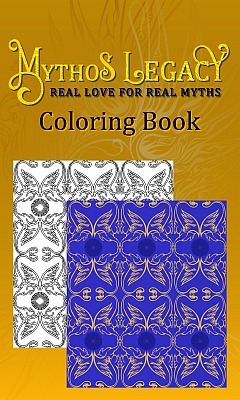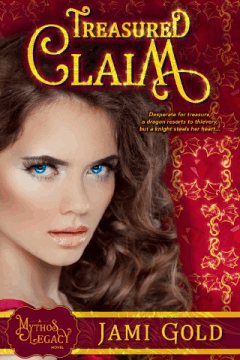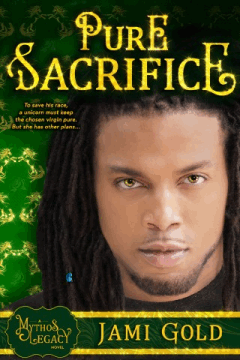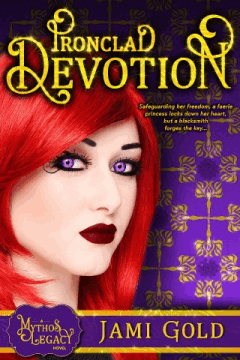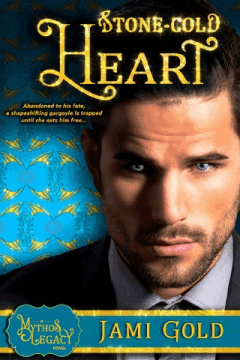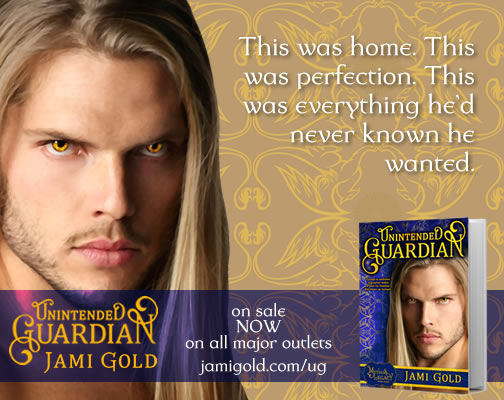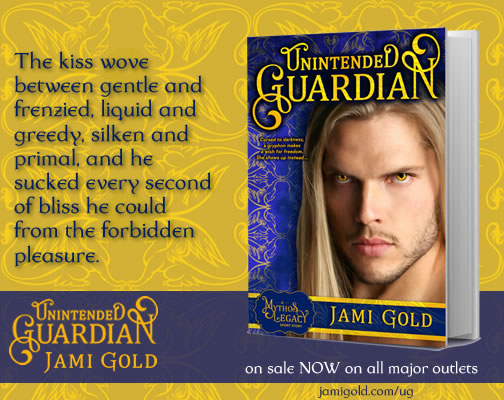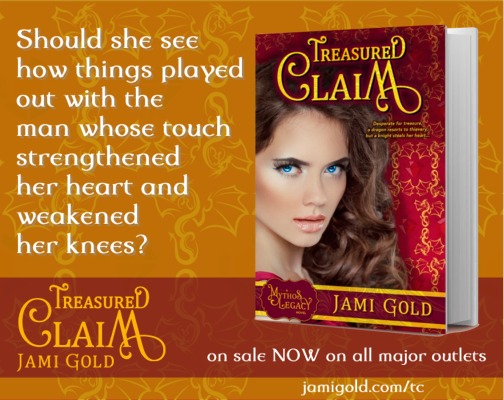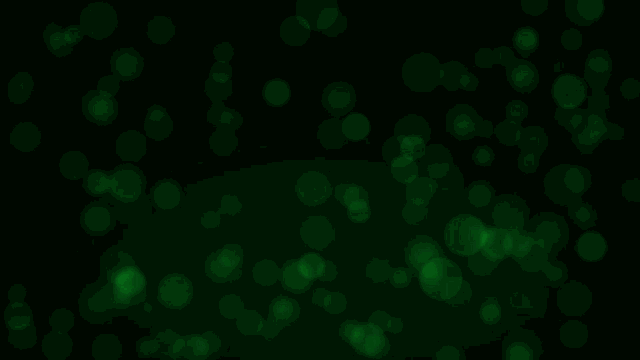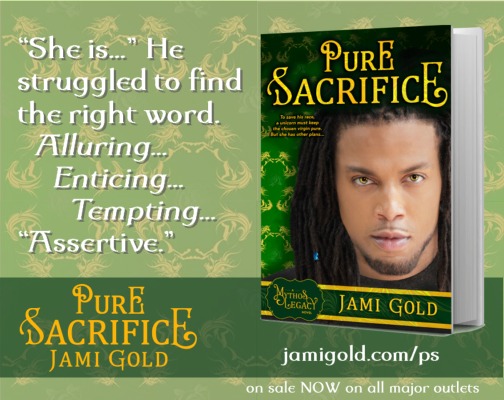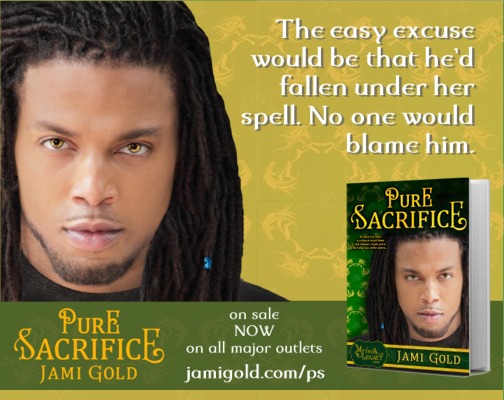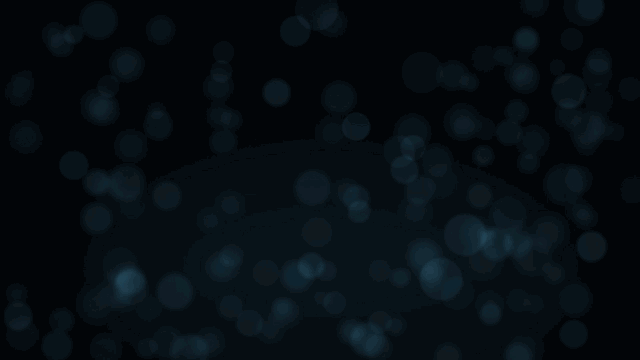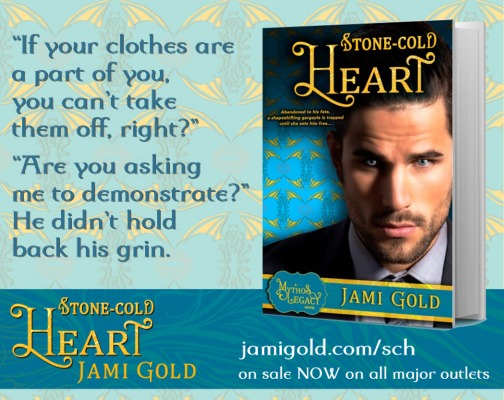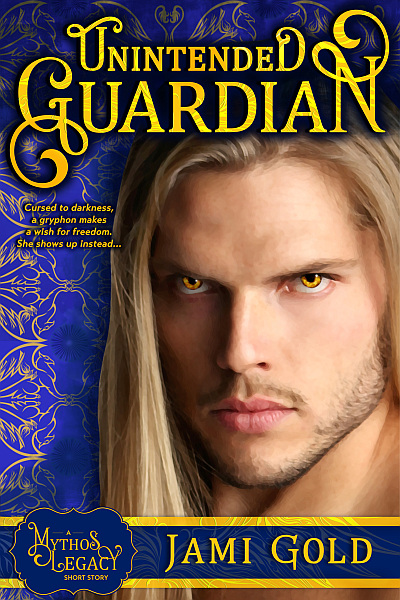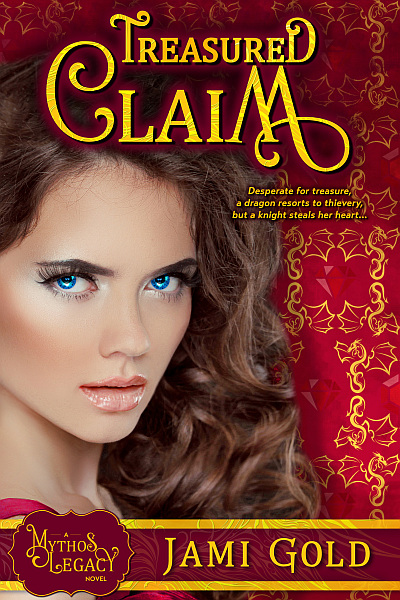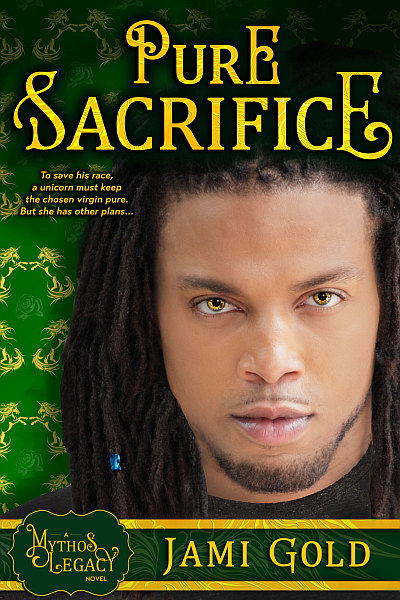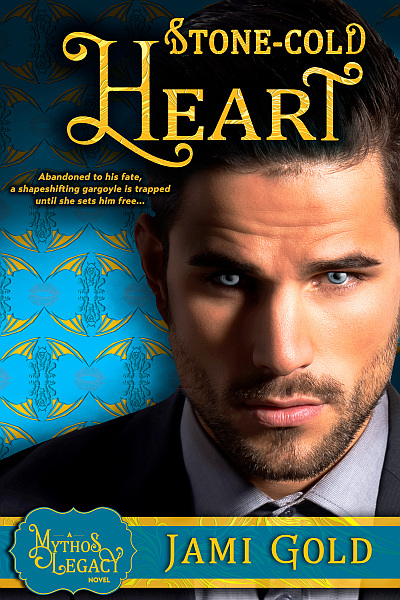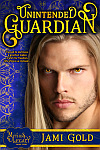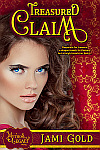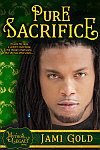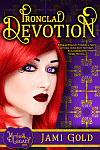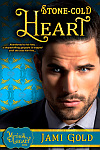All about the...

Paranormal Romance / Contemporary Fantasy Romance
“I want to be a part of Kira and Zac’s world, and couldn’t stop reading their story.”
LibraryNerdette, Shannon Terril, Librarian
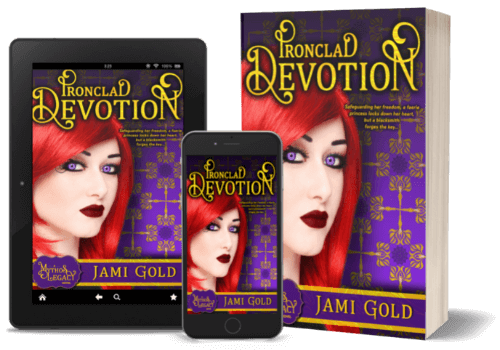
“Shows Ms. Gold’s vast imagination and talent at a whole new level.”
Reader Patti Y.
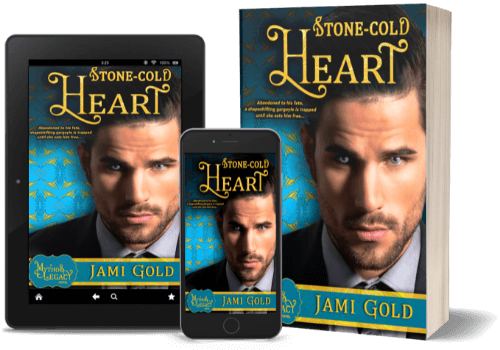
“The plot is fast-paced and reads as much like an adventure UF as a romance.”
Reader Wendy S.
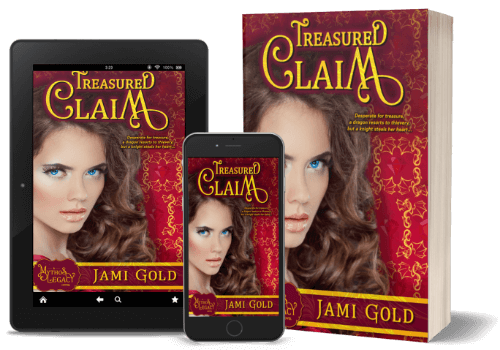
“This book was a wonderful original. I will buy the rest of the series.”
NetGalley Reviewer, Librarian
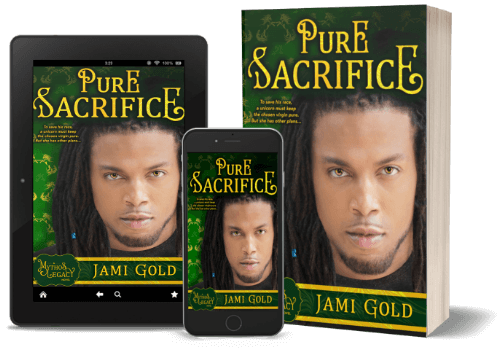
“Grabbed me at the first sentence and didn’t let go until the end of the final word.”
Reader Robin H.
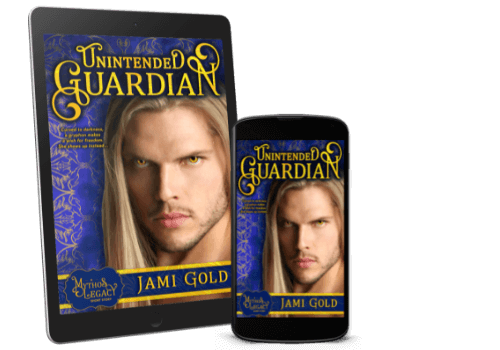
“Not at all what I was expecting, it was better. The chemistry between Alex and Elaina was beautifully written.”
Lovers of Paranormal, Maria D., Reviewer

“I don’t typically read romance, but I sped through the entire book in one night.”
Reader Lillian C.

“I wasn't sure about a gargoyle as a lead but I finished this book with a huge crush.”
Reader Lakshmi C.

“The characters, setting and world-building meshed to create a fascinating read.”
Reader Bran A.

“It’s hard to find a very short story that satisfies all the things you want in a story, but this one does.”
Moon Stars Review

“Excellent writing—check. Steamy love scenes—check. Want to find out what happens next—check.”
Reader Patti Y.

“The worldbuilding is almost unstoppable in how vivid it is.”
LibraryNerdette, Shannon Terril, Librarian

“A completely fresh approach. The hero Alex felt like a breath of fresh air.”
NetGalley Review

“I applaud this author for the creative risk she took and she should know that her risks paid off in full.”
Black Butterfly Review

“Pulled me in fast, created tension, and delivered a story that leaves me wanting to read more.”
Reader Kerry M.

“If you like your female leads feisty, this is the book for you.”
Book of the Moment Club

“If you’re interested in mythical creatures, you’ll definitely want to check out the latest by Jami Gold.”
Reader Sharon H.

“Her characters speak and act with deep emotion that jumps from the page, snares you and doesn’t let go.”
Reader Tamara L.

“The characters in this book, especially Raquel, drew me in and kept me turning the pages.”
Reader Sharon H.

Sign up for Jami's newsletter to get the latest updates on her book releases:
Discover more about the magic and history of the world of Mythos,
and learn how each of the stories tie into the Mythos World.
(Warning: Watch out for spoilers in the answers!)
Throughout history, many of those from Mythos used magic or shapeshifting abilities to hide their true nature while on the Earthen plane, especially when they didn't want to be discovered. The stories of our myths give evidence that some were more careful than others.
However, while changes in human society have made it more important than ever for Mythos beings to conceal themselves, human technology and the weakening magic have also made it harder for them to escape detection. Many have lost their ability to shapeshift or use magic, so all but a few stay away from humans and the Earthen plane.
The books of the Mythos Legacy are the stories of those few on Earth.
There are different types of magic on both the Earthen and Mythos planes. The magic of the Mythos plane has historically been stronger and more abundant, but it, too, has been fading like the magic of Earth.
Every creation on Mythos is tied to magic, from the beings of our mythology to the rocks, trees, water, etc. The different races of Mythos have all developed different ways to bind themselves to the magic of either world, whether they keep a spark inside themselves or use the elements to do their bidding...and so on.
At the same time, the various races have each discovered weaknesses in the others. Unicorns can use magic only in locations open to outside air, faeries are vulnerable to metal, dragons are weak without a hoard, etc. The avoidance and exploitation of those weaknesses have led to millennia-old alliances and rivalries, some of which are now breaking down.
Most races have their own homeland on the Mythos plane, and they often don't interact outside of official purposes. Because of that, they've each formed independent societies and unique cultures.
They each have different magical strengths and weaknesses, and they each have different ways of tapping into their magic. Many races might be able to strengthen their magic, although the details for how they could do so have been lost to time.
Even though there are significant physical differences between the races—dragons are quite different from unicorns after all—the most powerful races can all take on a human form (assuming they have enough access to magic). However, their human forms also have differences: all unicorns have dark skin and textured hair, dragons have iridescent skin due to their scales, etc.
Faeries are unique, as they're naturally humanoid. Each faerie clan is bound to a different elemental spirit (earth, wind, fire, water), and their physical features reflect their clan, with different hair, skin, and eye traits.
In the past, the beings from Mythos used to visit the Earthen plane frequently—that's the source of all our myths, after all.
However, the weakening magic has made it harder for Mythos beings to visit our world in recent memory. Ancient portals have closed, so only those with inherent magic can easily travel between planes now.
Also of note is that only living things can travel between planes without causing problems. Transporting non-living material from one plane to another would create an imbalance.
Griff explains how he knows his treasure is not on the Mythos plane—he’d feel an imbalance. This idea of the potential for an imbalance is revisited in future books.
Griff explains how his protection of a treasure is not like that of dragons, who own their treasure. The importance of his treasure bound to him echoes similar-but-different binding or claiming magic for the other races of Mythos.
Readers see that shapeshifting races might be able to shift in degrees, with just a claw if necessary, and some have extra abilities, such as healing magic.
In introduction, Griff mentions many of the other Mythos races for the first time: dragons, unicorns, faeries, gargoyles, and sirens.
The rules of gryphon society versus leprechauns’ magic hint at how each race has its own powers and limitations—and likely have different strengths and weaknesses against each other.
Treasured Claim takes place entirely on Earth, the only home Elaina has known, but Elaina’s mentor hints at the fact that Mythos exists. He references their former homeland and that faeries were involved with its loss. In addition, knights seem to have inherent memories of that homeland, with the mention of the Mythos sky and stars.
Readers see how easily dragons can control metal, which would be dangerous to any race vulnerable to certain types of metal.
Readers learn that Elaina’s “changeling” hair is not normally a trait of dragons—but of faeries.
Elaina’s magic, where she seems to communicate with inanimate objects to some extent, alludes to the nature of the Mythos plane and its elemental spirits.
Griff of Unintended Guardian explained how he knew his missing treasure couldn’t be on the Mythos plane because he would sense an imbalance. Readers see Markos’s efforts to prevent an imbalance while importing and exporting between Mythos and Earth.
Markos mentions why Mythos lacks iron, which hints at the danger of that metal to faeries.
Markos discovers connections between some faeries and unicorns, which continues to be important through future stories.
Markos and Archimedes wonder if faeries are in the midst of a civil war when making observations about their “helper.” The truth of the tumultuous situation is revealed in Ironclad Devotion.
Pure Sacrifice marks the first glimpse of the Mythos plane, at least of the unicorn homeland.
Treasured Claim mentioned that dragons used to have a homeland. Now, readers learn how they lost it, the reasons for the dragon-faerie war, and how dragons came to Earth.
In Treasured Claim, Elaina’s hair is described as “changeling,” which she inherited from her mother, who presumably had faerie blood in her lineage. Kira of Ironclad Devotion gives a detailed look at pure-blood changeling hair.
In Pure Sacrifice, Markos learns of connections between some faeries and unicorns. The reason why those faeries would have worked with unicorns is revealed here, as Kira learns the gargoyles are missing from the palace and new guards had been needed. The fallout of those connections for unicorns caught in the middle is also alluded to here.
More of the Mythos plane is explored, including the elemental spirits of the faerie homeland and of Mythos itself, as well as how each race taps into different styles of magic.
Like in Pure Sacrifice, we see Zac ensure the importation of non-living material doesn’t cause an imbalance between planes.
Treasured Claim and Ironclad Devotion both referred to a war between the dragons and the faeries. Now, readers learn more about how that battle was fought—and how the gargoyles were involved.
This story refers to Lirdeag and the fate of his daughter, which both play a big role in Ironclad Devotion.
In Ironclad Devotion, Kira notes the lack of gargoyles in the faerie palace, and this story explains their absence. The same explanation lies behind Markos’s discovery of connections between some faeries and unicorns in Pure Sacrifice.
The elemental spirits of the faerie homeland and of Mythos itself are mentioned in Ironclad Devotion, and the earth spirits of the world are again important here.
The lamians cause trouble in both Ironclad Devotion and Stone-Cold Heart.
Explore the overlap of our real-world myths with the Mythos Legacy series
and how the legends inspired aspects of the stories.
(Warning: Watch out for spoilers in the answers!)
*** Warning: Potential Spoilers Below...
Unintended Guardian plays with the legends of gryphons (griffins/griffons) and leprechauns, so there are many parallels between our myths and the story...
Real-World Mythology
Popular in mythology and art since ancient Egypt and Persia, gryphons are creatures with the head and wings of an eagle and the body of a lion. They were known in legends as the powerful king of all creatures, just as their lion half is known as "king of the beasts" (animals) and their eagle half is "king of the air" (birds).
In ancient Greek art, they were depicted with various gods, and their connection with Apollo then associated them with the sun, while their connection with Nemesis associated them with being protectors and guardians, especially of treasure and priceless objects that belonged to others, such as kings. Later Christian art incorporated gryphons as symbols of marital fidelity, as the myths portrayed gryphons as remaining with one partner for life, even after death. During the time of medieval Europe, gryphon myths brought back from the Christian Crusades into the Middle-East included beliefs in the healing properties of their claws and feathers.
Not surprisingly, gryphons symbolized many virtues, especially with their combination of lion (strength, courage, and majesty) and eagle (speed, watchfulness, and intelligence). They were popular for heraldry and even today can be seen in the iconography and motifs of many schools, businesses, and organizations.
Leprechauns are from Irish mythology and are usually seen as small, sometimes fairy-like, mischievous creatures. They're associated with gold and treasure (especially with pots of gold hidden at the end of rainbows), and they're often portrayed as granting wishes to those who capture them.
Although modern depictions show them as short, old bearded men clad in a green coat and hat, their earlier descriptions had them wearing red. In addition to the ability to grant wishes, they frequently are thought to have the power of teleportation. As symbols, they're often used for anything Irish-adjacent, from universities to breakfast cereal.
The Story within Unintended Guardian
The stories of the Mythos Legacy series take our real-world mythology and explore how they would apply to the beings if they really existed—but were hidden among us. In addition, these Mythos beings have their own storytelling legends, such as their myth of an oracle called the Great Owl, perhaps based on an owl associated with Athena, the Greek god of wisdom (One so wise as to see the future.).
Many of the ideas mentioned above, from guarding treasures to granting wishes, are echoed in Unintended Guardian. The story imagines what would happen to this blessed-by-the-sun being if he lost his treasure and became cursed instead. The story then explores the other mythological methods at his disposal he could use to try to regain his treasure, from oracles to leprechauns. The ideas of mating for life and healing abilities are both seen in the story as well.
A mischievous red-clad leprechaun also makes an appearance, along with his wish-granting and teleportation powers. Although the leprechaun doesn't seem to follow through with his promise after being captured, readers know that he found a way to help with the missing treasure. *grin*
*** Warning: Potential Spoilers Below...
Treasured Claim plays with the mythological ties between dragons and knights, so there are many parallels between the myths and the story...
Real-World Mythology
Almost every human culture includes mythology relating to their version of dragons. Some cultures' dragons are more serpent-like and others are more like giant lizards with wings. Some are seen as good or beneficial, and others are seen as monsters, often symbolizing invaders from other lands or cultures in the mythology tales.
The cultures that saw dragons more as monsters not surprisingly also saw them as monsters to fight. Accordingly, these cultures also created myths about those heroes who would be dragonslayers. These tales can be seen throughout history, starting long before the time of knights in medieval Europe. Ancient Greek mythology introduced the idea of dragons guarding treasure in a story with the hero Heracles, and Beowulf, the oldest story in the English language, features a battle between the hero and a dragon.
Unlike with the tragic tale of Beowulf, the weapons and armor associated with medieval European knights (plate armor, lances/spears, and swords) made it easier to tell stories where the hero would have a believable chance of surviving an encounter with a fire-breathing monster. That's especially the case if the story gave the dragon vulnerabilities, like an area where their scales couldn't protect their heart, brain, or other important organs from being pierced by pointed weapons, or like a setting of their treasure-filled cave, which prevented them from attacking while flying.
These concepts led to dragons frequently appearing in medieval romance and folklore, such as the famous tale of St. George and the Dragon, strengthening the mythological ties between dragons and knights. Despite their monstrous (and sometimes evil) mythological history, dragons were also seen as noble in this time period, explaining their prominent appearance in heraldry on coats of arms and becoming a symbol for many countries, armies, and leaders.
The Story within Treasured Claim
The stories of the Mythos Legacy series take our real-world mythology and explore how they would apply to the beings if they really existed—but were hidden among us. In addition, these Mythos beings have their own storytelling legends, such as to explain the human side of our real-world myths (Do dragonslayers really exist?).
Many of the ideas mentioned above, from tricky vulnerabilities to cave-bound treasure hoards, are echoed in Treasured Claim, which takes the idea of a fire-breathing-yet-noble monster and explores where that fire would come from within their body, why treasure would be so important to them, and how those details would affect their physiology and growth from youth to adult. In the story, dragons need treasure to mature and survive (as a source of energy). Therefore, only the hearts of adult dragons have ignited, allowing the fire-breathing attack, but also creating their weakness to those with the ability to see through the magic of their glamour.
In Treasured Claim, a "knight" is anyone with the ability to see through that glamour magic (and have the innate instincts to fight dragons, as well as their own magical abilities in the battle). In these dragons' own mythology, there's only one of these special humans in existence at a time, if they're believed to really exist at all. At the same time, these special "dragonslayer" humans feel compelled to protect the human race from monstrous dragons, which could cause problems if one happened to fall in love with a dragon. *grin*
*** Warning: Potential Spoilers Below...
Pure Sacrifice plays with the mythological ties between unicorns and virgins, so there are many parallels between our myths and the story...
Real-World Mythology
Unicorn mythology started with early Mesopotamian artwork and legends of India and China. They were described as resembling a horse or goat with a single (often spiraled) horn on its forehead.
Unicorns are unique among legends, as they are one of the few mythical creatures not associated with danger in any way. They were thought to be creatures of purity and grace but fierce and uncapturable, and in medieval times, they evoked ideas of chaste love and faithful marriage. In heraldry, unicorns symbolize freedom, power, and honor, and in modern times, they often symbolize rarity.
As its horn was said to have healing or protective powers, including neutralizing poison, many of the unicorn legends focused on how to hunt and capture one. However many of the original tales surrounding unicorns are actually found in bestiaries (natural history books) rather than fiction storybooks, as they were considered real animals until relatively recent times. Throughout history, descriptions of now-extinct oxen or rhinoceroses were often labeled as unicorns (such as by Marco Polo), and traders from the north sold narwhale tusks as unicorn horns (for large sums of money), all leading to difficulties in determining real versus myth. It didn't help that some translations of the Christian Bible discuss unicorns as real too.
The bestiary stories described unicorns as fast, fierce, and strong, especially in its horn, and so difficult to capture that it could be caught only if a virgin maiden was placed in its way. The story continued down a rather perverted path from there, as the unicorn was said to be compelled to stop and suckle from the virgin, especially if her breasts were bared. While the unicorn was lulled to sleep in her lap afterward, she could put a leash around its neck, essentially taming it and leaving it vulnerable to being killed by the hunters. No less than Leonardo da Vinci wrote about this "hunting" method of using a virgin as bait, mentioning the unicorn's inability to resist the virgin but skipping the sexual breast-baring, suckling aspect.
The Story within Pure Sacrifice
The stories of the Mythos Legacy series take our real-world mythology and explore how they would apply to the beings if they really existed—but were hidden among us. In addition, these Mythos beings have their own storytelling legends, such as to explain the human side of our real-world myths (Do unicorns consider virgins threatening and dangerous to them?).
Many of the ideas mentioned above, from a unicorn's powerful strength to their inability to resist virgins, are echoed in Pure Sacrifice. The story explores why unicorns are compelled to seek out a virgin, as well as the risks they take among them. In the story, unicorns are attempting to use virgins to hold off their impeding extinction. The magic of unicorns determines which virgin in the world is the Chosen Virgin with the potential to help them. However, they've been unsuccessful with every attempt until our heroine enters the picture.
To avoid fetishizing the idea of virginity, in the story, the heroine isn't special because she's a virgin. Instead, as the chosen woman, she's been manipulated and controlled to force her to conform to the unicorn tribe's needs. Rather than her virginity being a sign of her innate purity or goodness, it represents how—much like society's views of virginity in general—she hasn't been in control her own life until she forces the issue.
Unicorns in the story are warriors and thus much closer to the near-elephant size of many of the legends than the goat-sized creatures in some of the myths. The story also utilizes the "leash" and taming elements of mythology to show when he's been fully "captured" by her, as he switches primary allegiance from his unicorn tribe to prioritizing their relationship. Being a romance, the story also takes on the sexual aspect of the mythology, giving the heroine seductive powers over him that she's unaware of. At one point, he even thinks during a sexy scene that he'd be happy to die there at her breasts. *snicker*
*** Warning: Potential Spoilers Below...
Ironclad Devotion plays with the faerie legends of iron being dangerous to them and the power of a true name, so there are many parallels between our myths and the story...
Real-World Mythology
Faeries (fae/fay/fey/fair folk/fairies) are mythological beings found in the folklore of many cultures. Unlike many other legendary creatures, there are few commonalities among these stories, as they originated across disparate sources. Instead, the stories are often lumped together with the idea that "fae" is an umbrella term for many different types of creatures—from sprites, pixies, and brownies to leprechauns, trolls, and sometimes elves—that have a human appearance, magical powers, and often exhibit mischievous personalities.
Some stories portray faeries as tiny, and others are human-sized. Some can change their size at will, and others can take on the form of an animal or disguise their appearance with magic. Modern portrayals often give faeries wings, but the original folklore was more likely to give them the power of flight through magic rather than body extensions (if they had that power at all).
Along with wings, modern depictions tend to show faeries as beautiful, cute, and not-at-all scary, so people today often don't interpret their presence in stories as truly dangerous. However, throughout history, faeries were the top creature of myth to be feared, as they could be everywhere and anyone. The whole genre of fairy tales reflects their immense (often malicious) power, even though over time, the antagonists of the tales were relabeled sorcerers or enchantresses.
Because of their reputation, whenever people encountered bad luck (from losing an item to a seriously-ill child), faeries were often blamed, and people would try to figure out how they might have offended the creatures. Thus many beliefs related to faeries revolved around the idea of how humans could avoid offending the local fae folk, such as staying away from certain locations that were thought to be faerie haunts, paths, or gathering circles. Or humans might wear charms, like four-leaf clovers, to protect themselves from fae tricks, or use iron for protection.
Another common belief was that if a human knew the name of a particular faerie, they could summon the being and force them to do as they wanted, due to names having power. The well-known story of Rumpelstiltskin is an illustration of this idea. Some believed faeries' penchant for trickery came from their inability to lie and thus relied on twisting their words to hide the truth, especially when they would otherwise be held to keep a promise.
Other beliefs found throughout history include the idea that faeries were of angelic origin, guiding the processes of nature, such as the growth of plants. These beliefs focused on faeries as nature spirits or elementals, which are magical beings who embody one of the forces of nature and can exert power over that force.
The Story within Ironclad Devotion
The stories of the Mythos Legacy series take our real-world mythology and explore how they would apply to the beings if they really existed—but were hidden among us. In addition, these Mythos beings have their own storytelling legends, such as the source of their magical power (How could faeries make their elemental magic stronger?).
Many of the ideas mentioned above, from the avoidance of iron to the power of specific names, are echoed in Ironclad Devotion, and going along with the idea that faeries are extremely dangerous and not cute, these are human-sized beings with a long history of warfare (and sometimes outright genocide) and no wings. However, some ideas from the faerie folktales have been changed quite a bit for the story, such as using the term changeling to refer to their power to change their appearance rather than of child abduction.
Also, instead of using the well-known Scottish legends of the Seelie and Unseelie Courts for worldbuilding, this story expands the ideas of elemental faeries into clans of the four classical elements of nature (earth, wind, fire, water). Each clan has slightly different magical powers and roles in their society, and the spirits of nature (along with faerie circles for each clan spirit) are important in the overall story.
Just like any human, mythological beings need vulnerabilities for storytelling (especially as they increase in power), so while it's never stated that these fae can't lie, they seem to deflect with a different truth when others might just lie in their place (especially as they are held to the power of a promise through an unbreakable magical bond), but they also have the ability to force humans to speak the truth to them as well. Most importantly, the danger of iron and the power of a faerie's true name are both emphasized and used against them in the story. In fact, as a faerie princess of the fire clan, the heroine of this story is so powerful that a man of iron who knows her true name might be the only human who could match her strength. *grin*
*** Warning: Potential Spoilers Below...
Stone-Cold Heart plays with the legends of gargoyles, stone circles, and where they both come from, so there are many parallels between our myths and the story...
Real-World Mythology
Our gargoyle mythology grew out of the use of gargoyles (water spouts) and grotesques (decorative-only) on buildings, starting with designs found in ancient Egypt, Greece, and Rome. The practical purpose of gargoyles is to act as gutters and downspouts, keeping rain water from running down the sides of buildings and eroding the mortar. From a mythology perspective, these architectural elements were believed to protect the building or area from evil spirits, acting like a sacred stone scarecrow.
The idea that these statues might come to life is far more recent — and these brought-to-life beings are more likely to have negative connotations in their stories than their non-living brethren due to the various explanatory myths for how they came to life. Some stories say the statues were brought to life (or created) through magic (often by an evil wizard), while others blamed demon possession.
In comparison, stories of good living gargoyles are even more recent. The stone architectural gargoyles were sometimes thought to come to life at night to fight any lurking evil spirits, and then revert to stone during the day (as they obviously weren't moving then). Depending on the specific legend, gargoyles may or may not be conscious during their daytime stone hours, as some were able to watch over places even through their stone exterior.
The original legend of gargoyles also involves dragons, as the story says the body of a defeated dragon (named La Gargouille) was burned, but after its fire-breathing head survived the flames, it was mounted onto the local church as a warning to others. Magical abilities commonly associated with gargoyles include immortality, shapeshifting into human form, winged flight, and invulnerability in their living form, while sunlight is a common weakness.
Stone circles are rings of standing stones, such as Stonehenge. Archeologists have theorized the purposes and uses of these ancient structures, but much remains a mystery, especially as they've been found all over the world, with the oldest ones in Egypt and India. In general, stone circles would have required significant effort and skills from these ancient cultures to build, so the theories behind their construction—such as astronomical observations—still feel lacking to many.
They're often considered sacred spaces even today, as they're thought to previously be places for ceremonies, funerals, burials, or worship. Myths and superstitions cling to many of the circles, with warnings to avoid them, to watch out for curses, or to go with only certain intentions. Others are believed to be petrified giants, or used for human sacrifice rituals.
The Story within Stone-Cold Heart
The stories of the Mythos Legacy series take our real-world mythology and explore how they would apply to the beings if they really existed—but were hidden among us. In addition, these Mythos beings have their own storytelling legends, such as to explain their questions about the world (Do gargoyles have a soul?).
Many of the ideas mentioned above, from how (and why) gargoyles were created to the purpose of a stone circle, are explored in Stone-Cold Heart. The story reveals that gargoyles were created to be soldiers in a war, and all the limitations and weaknesses in their abilities—from what they need to do to avoid their stone form to restrictions on children—are due to their creators attempting to keep them from becoming too powerful.
The magical abilities listed above all apply, but sunlight isn't always a weakness for these gargoyles. However, their stone form is a time a real vulnerability for them, and the differences between their forms is a major part of the story. The stone circle in the story is special in acting as a portal to Mythos, and the hero suspects the human-made stone circles we know were just copycats of the gargoyle version. The heroine teases him about being a grotesque rather than a gargoyle—according to the "official" definition anyway—but she admits she doesn't find him gross at all. *snicker*
No, you don't need to read the stories in the Mythos Legacy series in order. Each story in this series stands alone, and each book features a different couple with their own journey to love.
That said, there are some connections between the stories, so if you're the type to enjoy "easter eggs" that refer to other stories, you might prefer to read the stories in order. However, the story world of Mythos can be entered with any book of the series as an entrance point.
I understand. We all have our preferences, triggers, and peeves.
That's why I have a central place to check for information about content in my stories.
If you scroll down on each book's page, you'll find tabs with teaser graphics, hints of how the story ties to the other books, and behind-the-scenes information.
In addition to the teaser graphics and background information on each book's page, I've had fun creating animated gifs for each cover and a coloring book for the whole series!
Animated Gifs:
In addition to finding each story's excerpt on their page, you can find them all right here:
Like many readers, I was first introduced to the paranormal romance genre through vampire stories. Later came shifter stories in the form of werewolves. Then in 2010, I read my first shapeshifter story for a race that wasn't commonly thought of as a shifter: a dragon.
A whole world of possibilities opened before my eyes, but of course, I wanted to do something different. So I came up with a female dragon shapeshifter and thought about what type of person she'd be. Elaina, my jewel thief of Treasured Claim, was born, and she soon had me obsessed with telling her story.
After that, I wanted to expand the idea into a series, so I started thinking about other mythological beings I could develop. To explain where they all came from (and usually lived), the Mythos plane, the source of Earth's mythology, came to be. And I've been happily sharing their stories ever since!
I have ideas for at least three more stories in the Mythos Legacy series, so new books will release just as fast as I can write them. (Fair warning: I'm not as fast of a writer as I'd like to be.)
I'm also working on a spinoff series called Brothers of Stone based on Stone-Cold Heart, the fourth Mythos Legacy novel. The spinoff follows the adventures of the gargoyles of Garrett’s regiment as they discover the possibilities of their new life.
I'm lucky in that when I write, I don't waste time with scenes that are later deleted. Everything I type into a draft is there for a reason (even if it takes me a while to recognize its purpose.)
However, that means I don't have deleted scenes to share with my readers. Someday, I might create bonus slice-of-life or epilogue-style scenes to share, but right now, my focus is on writing my books.
The Mythos Legacy series is a tricky one to come up with a cover design that works for all the books. Paranormal romance books often feature a lot of man-chest, moonlight, and fangs for vampire-type stories or a wolf, bear, or whatever in the background for shifter-type stories.
However, not every book in Mythos features a shifter, and more importantly, half of the books star a human hero, as the heroine is the paranormal member of the couple. In other words, it would be difficult to include a focus on the guy and the paranormal aspect of the story at the same time.
The other main style of cover is to include the hero and heroine together in a "clinch" pose. But as my characters (human and paranormal) come in all colors, and the vast majority of stock photos used for cover images feature white models, I knew it'd be hard to find good matches for that approach as well.
My current cover design tries to capture a fantasy, a romance, and a paranormal look—all in one. I'm not sure if I was entirely successful, but until I have a better idea, I'll enjoy them as they are.
Some of the design is determined by how the paranormal character alternates between a hero and a heroine from book to book. Accordingly, my covers alternate sides (with the face along the spine vs. along the pages) and colors (red shades vs. blue shades) with each book to match the paranormal character (heroine vs. hero).
As for "hidden" meanings, if you look closely, the background of each book includes a secondary image significant to the story in addition to the depiction of the character:
- Gryphon and Sunlight: The sun is both the symptom of Griff's curse and the imagery for Kala in Unintended Guardian.
- Dragon and Ruby: The ruby is both symbolic of Elaina's need for treasure and an image of her talisman in Treasured Claim.
- Unicorn and Rose: Markos always describes Celia with rose imagery and she grows into her strengths in Pure Sacrifice.
- Fire Faerie and Mandala: The design on Kira's palm focuses her power, which she tries to control in Ironclad Devotion.
- Gargoyle and Lips: A kiss is very important when Raquel uses it to awaken Garrett in Stone-Cold Heart.
If you love the Mythos Legacy series, help spread the word to other readers!
Add the stories on Goodreads or
grab images, GIFS, and videos to share on social media…

